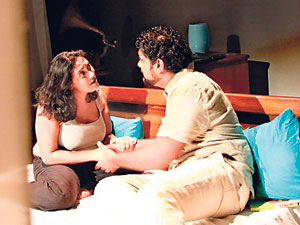Sathya – Shades of Gray was a short play presented by the Women’s Support Group in collaboration with the TrikonE Cultural Centre in Colombo last month. The performance was directed by Dharmasiri Bandaranayake and produced by Upeksha Thabrew, Ranga Bandaranayake and Shastri Mallawarachchi.
The performance was for a select audience perhaps because of the sensitivity of the subject. A public review, however, is in order as most significantly the performance gave voice to the often-silenced story of female sexuality and warrants discussion in a public arena. This review thus considers the politics of the performance.
The Women’s Support Group has since 1999 worked for the rights of lesbians, bisexual women and transgender persons (LBT) in Sri Lanka and is perhaps one of the few organisations working for women’s sexual rights.
Therefore, we entered the Punchi Theatre with high expectations for the performance to inform or clearly represent the complexities of women’s sexuality in the Sri Lankan socio-political context. The narrative that formed the basis of the performance was the fundamental issue or obstacle in this regard.
The first scene on stage after the opening dance is of Sathya communicating with her lover on the phone. In the background we have her husband moving around what is their bedroom.
As the story unfolds we are given a sense of Sathya and Nirosh’s eight-year relationship that preceded their marriage, which at the point of this presentation is in its first year. In a conversation between the two, it is made evident that Nirosh has, over time, accepted his wife’s sexuality and has clearly felt secure enough to commit to her. The problem lies with her choice to continue a relationship with a woman after their marriage.
Whether the character of Sathya is lesbian or bisexual is not emphasised and we will not concern ourselves in that regard. But we do see a woman who has had the privilege of experimenting with her sexuality; this is not a privilege that is enjoyed by most women or even men in Sri Lanka. She then chooses to marry Nirosh. And through a series of choices she makes in the course of the performance, she appears empowered and confident enough to leave her husband for another woman.
This is an exception. Furthermore, seen through the life of Sathya, the story was a privileged account of sexuality.
The narrative was thus invested in Sathya and her husband, and as a subplot in the character of her lover Deshini. Sathya’s expression of her sexuality is therefore revealed to the audience as an ‘extra marital affair’. This complicated the expression of lesbian sexuality that should have been the central focus of the performance. While it is accepted that a heterosexual marriage is the reality of many women who are attracted to women, through habitual or violent social pressures, the fact that the marriage became the focus of the performance framed the story of lesbian sexuality within a heteronormative context. This was a problem, primarily as this was a work of theatre activism, where the need to view female sexuality outside of a heteronormative context is vital.
A discussion followed the performance, and to accusations from some audience members that the story was unrealistic the cast responded with the fact that it was a true story. The development of the script was credited to the members of the Women’s Support Group and while the authenticity of the story is not doubted, performed as it was, it didn’t communicate. An artistic choice to work with the perspective of the story to reflect the complexity of same sex relationships and the politics of female sexuality within a Sri Lankan socio-political context would have strengthened the performance and conveyed directorial and activist commitment.
The second dimension of the Sathya narrative was that of her lover. Deshini’s place in the narrative was important enough to have been drawn out as the focus of the evening’s piece. Compelling as a character and in terms of her story, Deshini captured the complexity of trying to live as a woman of an alternative sexuality struggling against the absolute frustration of confronting familial pressure. This was communicated in the performance, and had the performance focused on this perspective, the audience would have been exposed to some of the complexities of this true story, without the complication of the choices made by Sathya which when depicted on stage seemed oddly frivolous.
The issues with having family and community accept a woman’s choices in regard to her sexual identity are further intensified as that choice is framed within the reality of legal criminalisation.
The performance is thus significant in terms of its place as an articulation of a queer identity and queer art. Its consideration of a female sexuality in particular in terms of a true story is significant. As important is the fact that the medium of theatre was used in this act of expression and what was hopefully some kind of communication.
Jake Oorloff and Ruhanie Perera |

